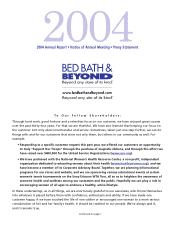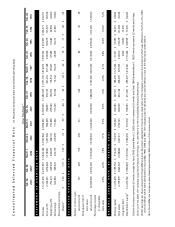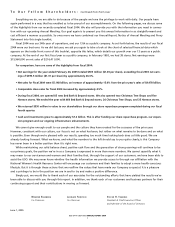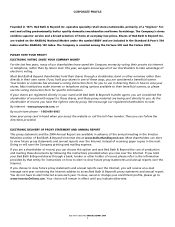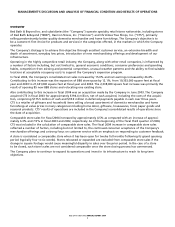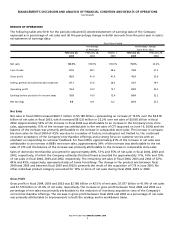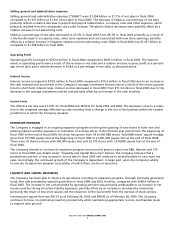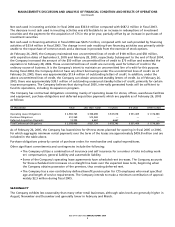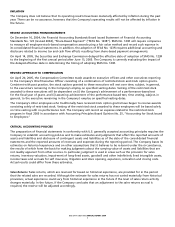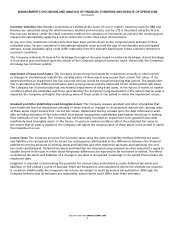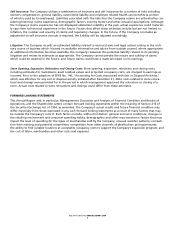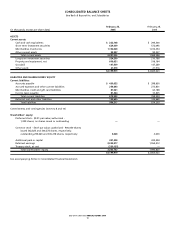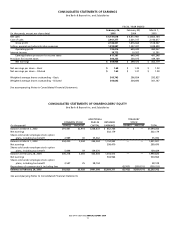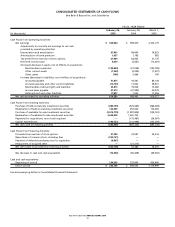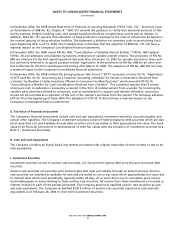Bed, Bath and Beyond 2004 Annual Report Download - page 10
Download and view the complete annual report
Please find page 10 of the 2004 Bed, Bath and Beyond annual report below. You can navigate through the pages in the report by either clicking on the pages listed below, or by using the keyword search tool below to find specific information within the annual report.
BED BATH & BEYOND ANNUAL REPORT 2004
8
Inventory Valuation: Merchandise inventories are stated at the lower of cost or market. Inventory costs for BBB and
Harmon are calculated using the retail inventory method and inventory cost for CTS is calculated using the first-in,
first-out cost method. Under the retail inventory method, the valuation of inventories at cost and the resulting gross
margins are calculated by applying a cost-to-retail ratio to the retail value of inventories.
At any one time, inventories include items that have been written down to the Company’s best estimate of their
realizable value. Factors considered in estimating realizable value include the age of merchandise and anticipated
demand. Actual realizable value could differ materially from this estimate based upon future customer demand or
economic conditions.
The Company estimates its reserve for shrinkage throughout the year, based on historical shrinkage. Actual shrinkage
is recorded at year-end based upon the results of the Company’s physical inventory count. Historically, the Company’s
shrinkage has not been volatile.
Impairment of Long-Lived Assets: The Company reviews long-lived assets for impairment annually or when events
or changes in circumstances indicate the carrying value of these assets may exceed their current fair values. If it is
determined that an impairment loss has occurred, the loss would be recognized during that period. The impairment
loss is calculated as the difference between asset carrying values and the estimated future undiscounted cash flows.
The Company has not historically had any material impairment of long-lived assets. In the future, if events or market
conditions affect the estimated cash flows generated by the Company’s long-lived assets to the extent that an asset is
impaired, the Company will adjust the carrying value of these assets in the period in which the impairment occurs.
Goodwill and Other Indefinitely Lived Intangible Assets: The Company reviews goodwill and other intangibles that
have indefinite lives for impairment annually or when events or changes in circumstances indicate the carrying value
of these assets might exceed their current fair values. Impairment testing is based upon the best information avail-
able including estimates of fair value which incorporate assumptions marketplace participants would use in making
their estimates of fair value. The Company has not historically recorded an impairment to its goodwill and other
indefinitely lived intangible assets. In the future, if events or market conditions affect the estimated fair value to
the extent that an asset is impaired, the Company will adjust the carrying value of these assets in the period in which
the impairment occurs.
Income Taxes: The Company accounts for its income taxes using the asset and liability method. Deferred tax assets
and liabilities are recognized for the future tax consequences attributable to the differences between the financial
statement carrying amounts of existing assets and liabilities and their respective tax bases and operating loss and
tax credit carryforwards. Deferred tax assets and liabilities are measured using enacted tax rates expected to apply to
taxable income in the year in which those temporary differences are expected to be recovered or settled. The effect
on deferred tax assets and liabilities of a change in tax rates is recognized in earnings in the period that includes the
enactment date.
Judgment is required in determining the provision for income taxes and related accruals, deferred tax assets and
liabilities. In the ordinary course of business, there are transactions and calculations where the ultimate tax outcome
is uncertain. Additionally, the Company’s tax returns are subject to audit by various tax authorities. Although the
Company believes that its estimates are reasonable, actual results could differ from these estimates.
MANAGEMENT’S DISCUSSION AND ANALYSIS OF FINANCIAL CONDITION AND RESULTS OF OPERATIONS
(continued)

